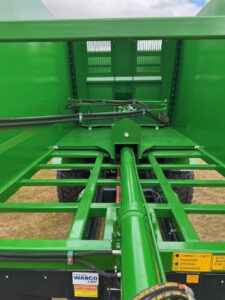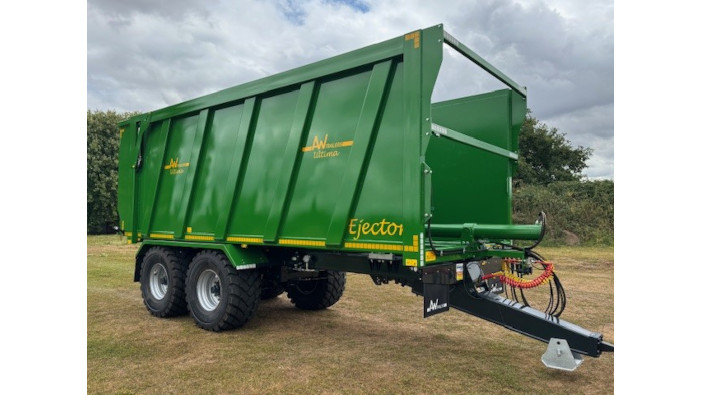Making its debut at the Royal Welsh Show, AW Trailer’s new Ultima Ejector brings the company into the compactor/ejector trailer market
Herefordshire manufacturer AW Trailers has been manufacturing trailers and nurse tanks since 1993, with a full range of tipping trailers, bale trailers and dump trailers in capacities up to 24t and constructed with Hardox steel.
Now the company is filling a gap in that portfolio with the launch of the Ultima Ejector – name subject to change – which managing director Andrew Watkins says has been under consideration for five years. “I was hesitant at first. A lot of manufacturers were going down the ejector trailer route, but we are working at a smaller scale, and any new development removes manpower from the production line,” he says.
Recognising that there was potential, he followed the market and now believes that the time is right to introduce an AW Trailers machine. “We’ve seen trailer capacities increase, which means tipping trailers may no longer be suitable in certain farmyards. As contractors handle more work for anaerobic digesters, they are also having to fill in more risk assessments, and if there are power lines overhead or low buildings, then tipping trailers can be an issue.”
Compact but capable
The first ejector trailer model has an 18t capacity, capable of holding around 30cu m, plus an additional 30% if compacting forage crops. It’s also designed to be grain-tight, meaning that it can be used for a range of operations. The ejection system uses a moving front wall and floor, which is hydraulically driven through the tractor’s spool block. Andrew notes that the unit has a hydraulic capacity of 68 litres.
As well as the safety benefits of not having a tipping trailer, Andrew adds that the Ultima Ejector is more compact than previous models in the range. The 18t has similar dimensions to a 16t tipper and has been built using the same high-tensile steel, meaning there is no distortion in the main body of the trailer.
 It’s mounted on commercial running gear, supplied by BPW, with a host of features to showcase the maximum specification. “As this is our first ejector trailer, we’ve added as many features as possible to showcase what is available. This machine has air brakes, hydraulic suspension and steering, all of which will be available as options,” Andrew explains.
It’s mounted on commercial running gear, supplied by BPW, with a host of features to showcase the maximum specification. “As this is our first ejector trailer, we’ve added as many features as possible to showcase what is available. This machine has air brakes, hydraulic suspension and steering, all of which will be available as options,” Andrew explains.
Andrew has opted for 560/60 R25.5 Vredestein Endurion tyres, which he says are an excellent agricultural tyre for both road and field use. Another option is a four-point weighing system from Griffith Elder – a system used widely across the AW Trailers range. This is available from the factory, with every machine equipped with dummy pads that can be easily slipped out and replaced with the weighing units if required.
Custom builds
Producing around 200 machines a year, Andrew says that AW Trailers has built its reputation on flexibility: working with customers to produce bespoke haulage solutions. As such, he expects the Ultima Ejector to follow a similar production route.
The base model will have mechanical suspension and a non-steering axle, and the options list will extend, within reason, to whatever a customer needs. Andrew believes that around 80-90% of the final design of any product is heavily influenced by customer feedback, and he’s keen to get people in the seat to test the Ultima Ejector.
“We’re happy to be guided when it comes to modifications down the line,” Andrew says. “Some of our customers have had experience with other models of ejector trailers because we haven’t offered one before. It makes sense to utilise their experience and adapt the design as we go.”
This will initially take the shape of a demo tour in the weeks after the Royal Welsh Show, where the company can pick up feedback from potential customers. Following this, the company will continue to offer adaptions to the base model to suit different requirements.
“We’re also looking at different capacities down the line. Perhaps not smaller models because of how compact the ejector trailers are, but definitely a triaxle model with a 24t capacity and perhaps a 20t model to fill the gap in the range,” he concludes.



